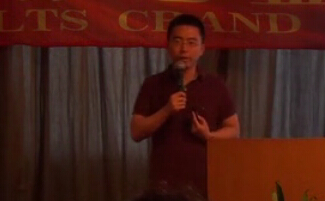雅思阅读之业余自然爱好者
2014-04-09 10:45 供稿单位: 新航道
出国英语考试有哪些 雅思6.5是什么水平 雅思阅读评分标准 托福阅读评分标准 雅思和托福的区别
READING PASSAGE 3 (对应考试日期:2011年4月2日 2007年12月13日)
You should spend about 20 minutes on Questions 27-40 which are based on
Reading Passage 3 below.
Amateur Naturalists
From the results of an annual Alaskan betting contest to sightings of migratory birds, ecologists are using a wealth of unusual data to predict the impact of climate change.
A Tim Sparks slides a small leather-bound notebook out of an envelope. The book’s yellowing pages contain beekeeping notes made between 1941 and 1969 by the late Walter Coates of Kilworth, Leicestershire. He adds it to his growing pile of local journals, birdwatchers’ lists and gardening diaries. “We’re uncovering about one major new record each month,” he says, “I still get surprised.” Around two centuries before Coates, Robert Marsham, a landowner from Norfolk in the east of England, began recording the life cycles of plants and animals on his estate — when the first wood anemones flowered, the dates on which the oaks burst into leaf and the rooks began nesting. Successive Marshams continued compiling these notes for 211 years.
B Today, such records are being put to uses that their authors could not possibly have expected. These data sets, and others like them, are proving invaluable to ecologists interested in the timing of biological events, or phenology. By combining the records with climate data, researchers can reveal how, for example, changes in temperature affect the arrival of spring, allowing ecologists to make improved predictions about the impact of climate change. A small band of researchers is combing through hundreds of years of records taken by thousands of amateur naturalists. And more systematic projects have also started up, producing an overwhelming response. “The amount of interest is almost frightening,” says Sparks, a climate researcher at the Centre for Ecology and Hydrology in Monks Wood, Cambridgeshire.
C Sparks first became aware of the army of “closet phenologists”, as he describes them, when a retiring colleague gave him the Marsham records. He now spends much of his time following leads from one historical data set to another. As news of his quest spreads, people tip him off to other historical records, and more amateur phenologists come out of their closets. The British devotion to recording and collecting makes his job easier — one man from Kent sent him 30 years’ worth of kitchen calendars, on which he had noted the date that his neighbour’s magnolia tree flowered.
D Other researchers have unearthed data from equally odd sources. Rafe Sagarin, an ecologist at Stanford University in California, recently studied records of a betting contest in which participants attempt to guess the exact time at which a specially erected wooden tripod will fall through the surface of a thawing river. The competition has taken place annually on the Tenana River in Alaska since 1917, and analysis of the results showed that the thaw now arrives five days earlier than it did when the contest began.
E Overall, such records have helped to show that, compared with 20 years ago, a raft of natural events now occur earlier across much of the northern hemisphere, from the opening of leaves to the return of birds from migration and the emergence of butterflies from hibernation. The data can also hint at how nature will change in the future. Together with models of climate change, amateurs’ records could help guide conservation. Terry Root, an ecologist at the University of Michigan in Ann Arbor, has collected birdwatchers’ counts of wildfowl taken between 1955 and 1996 on seasonal ponds in the American Midwest and combined them with climate data and models of future warming. Her analysis shows that the increased droughts that the models predict could halve the breeding populations at the ponds. “The number of waterfowl in North America will most probably drop significantly with global warming,” she says.
F But not all professionals are happy to use amateur data. “A lot of scientists won’t touch them, they say they’re too full of problems,” says Root. Because different observers can have different ideas of what constitutes, for example, an open snowdrop. “The biggest concern with ad hoc observations is how carefully and systematically they were taken,” says Mark Schwartz of the University of Wisconsin, Milwaukee, who studies the interactions between plants and climate. “We need to know pretty precisely what a person’s been observing — if they just say ‘I noted when the leaves came out’, it might not be that useful.” Measuring the onset of autumn can be particularly problematic because deciding when leaves change colour is a more subjective process than noting when they appear.
G Overall, most phenologists are positive about the contribution that amateurs can make. “They get at the raw power of science: careful observation of the natural world,” says Sagarin. But the professionals also acknowledge the need for careful quality control. Root, for example, tries to gauge the quality of an amateur archive by interviewing its collector. “You always have to worry— things as trivial as vacations can affect measurement. I disregard a lot of records because they’re not rigorous enough,” she says. Others suggest that the right statistics can iron out some of the problems with amateur data. Together with colleagues at Wageningen University in the Netherlands, environmental scientist Arnold van Vliet is developing statistical techniques to account for the uncertainty in amateur phenological data. With the enthusiasm of amateur phenologists evident from past records, professional researchers are now trying to create standardized recording schemes for future efforts. They hope that well-designed studies will generate a volume of observations large enough to drown out the idiosyncrasies of individual recorders. The data are cheap to collect, and can provide breadth in space, time and range of species. “It’s very difficult to collect data on a large geographical scale without enlisting an army of observers,” says Root.
H Phenology also helps to drive home messages about climate change. “Because the public understand these records, they accept them,” says Sparks. It can also illustrate potentially unpleasant consequences, he adds, such as the finding that more rat infestations are reported to local councils in warmer years. And getting people involved is great for public relations. “People are thrilled to think that the data they’ve been collecting as a hobby can be used for something scientific — it empowers them,” says Root.
Questions 27-33
Reading Passage 3 has eight paragraphs A-H.
Which paragraph contains the following information?
Write the correct letter A-H in boxes 27-33 on your answer sheet.
27 The definition of phenology
28 How Sparks first became aware of amateur records
29 How people reacted to their involvement in data collection
30 The necessity to encourage amateur data collection
31 A description of using amateur records to make predictions
32 Records of a competition providing clues for climate change
33 A description of a very old record compiled by generations of amateur naturalists
Questions 34-36
Complete the sentences below with NO MORE THAN TWO WORDS from the passage.
Write your answers in boxes 34-36 on your answer sheet.
34 Walter Coates’s records largely contain the information of ____.
35 Robert Marsham is famous for recording the ______ of animals and plants on his land.
36 According to some phenologists, global warming may cause the number of waterfowl in North America to drop significantly due to increased _______.
Questions 37-40
Choose the correct letter A, B, C or D.
Write your answers in boxes 37-40 on your answer sheet.
37 Why do a lot of scientists discredit the data collected by amateurs?
A Scientific method was not used in data collection.
B Amateur observers are not careful in recording their data.
C Amateur data is not reliable.
D Amateur data is produced by wrong candidates.
38 Mark Schwartz used the example of leaves to illustrate that?
A Amateur records can’t be used.
B Amateur records are always unsystematic.
C The color change of leaves is hard to observe.
D Valuable information is often precise.
39 How do the scientists suggest amateur data should be used?
A Using improved methods.
B Be more careful in observation.
C Use raw materials.
D Applying statistical techniques in data collection.
40 What’s the implication of phenology for ordinary people?
A It empowers the public.
B It promotes public relations.
C It warns people of animal infestation.
D It raises awareness about climate change in the public.
真题解析
Reading Passage 3. Natural Amateurs
题目详解
Questions 27-33
思路:
“Which paragraph contains the following information?”这种题型对大多数考生来说是最费事、最难的题型,但是该题型却总是文章的组题。正确处理这种题型的策略是把该题型放在去做,解答时多利用反向思维和下位词进行思考。
解答:
27. “phenology”明显是一个专业词汇,在文章中不会出现同义替换,且一个专业词汇的“definition”应该在次提到这个词汇的地方,所以可以回原文直接定位于段落B 第三行“…the timing of biological events, or phenology”,所以phenology 就是生物气候学,答案为B。
28. 利用人名细节词“Sparks”和反向思维词“first”很容易定位于段落C 句话“Sparks first became aware of the army of ‘closet phenologists’, as he describes them…”,所以答案为C。
29. 此题难度较高, 对应段落H 一句话“People are thrilled to think that the data they’ve been collecting as a hobby can be used for something scientific…”,原文“thrilled” 对应题目“reaction”,所以答案为H。
30. 此题难度也较高,对应段落G 一句话“It’s very difficult to collect data on a large geographical scale without enlisting an army of observers”,所以答案为G。
31. 利用反向思维词“using amateur records”和“predictions”来判断,原文对应信息应出现一些数据或未来的时间。该题对应段落E 中部“Terry Root, an ecologist at the University of Michigan in Ann Arbor…” 之后的所有信息。“birdwatcher’s counts of waterfowl”对应“amateur records”,两句话对应“predictions”,所以答案为E。
32. 利用细节词“a competition”可以定位于段落D 一句话“The competition has taken place annually on the Tenana River…”,所以答案为D。
33. 利用反向思维词“a very old record”,可以判断原文对应信息中应该会出现时间,并讲到一个具体的“record”。对应信息为段落A 一句话“Successive Marshams continued compiling these notes for 211 years”。原文“successive Marshams”对应题目“generations of amateur naturalists”,原文“211 years”对应“very old”。所以答案为A。
Questions 34-36
解答:
34. 利用细节词“Walter Coates” 定位于段落A 第二行“The book’s yellowing pages contain beekeeping notes…by the late Walter Coates”,所以答案为beekeeping。
35. 利用细节词“Robert Marsham” 定位于段落A 第六行“Robert Marsham…began recording the life cycles of plants and animals on his estate”,所以答案为life cycles。
36. 利用细节词“global warming”和“waterfowl in the North America”定位于段落E倒数第四行“Her analysis shows that the increased droughts…could halve the breeding population…”,所以答案为droughts。
Questions 37-40
解答:
37. 利用细节信息“scientists discredit the data”定位于段落F 、二句话“A lot of scientists won’t touch them, they say they’re too full of problems”。原文“won’t touch them”对应题目“discredit”,选项C“not reliable”对应原文“too full of problems”,所以答案为C。
38. 利用细节词“Mark Schwartz”和“leaves”定位于第11 页段落F 行“We need to know pretty precisely what a person’s been observing— if they say ‘I noted when the leaves came out’, it might not be that useful”。破折号这里表示后半句是对前半句解释说明的例子,所以使用叶子的例子是为了说明观察要“precise”,对应选项D,所以答案为D。
39. 本题较难,没有明显可以用来定位的细节词,但是利用顺序原则可以定位于段落G 前半部分。选项B“be more careful”的信息原文没有提及,所以排除。选项C“using raw materials”则明显与原文内容相悖,因为amateur records 必须进行严格的“quality control”。选项D“applying statistical techniques in data collection”虽然对应原文G 段落第七、八行“Others suggest that the right statistics can iron out some of the problems with amateur data”,但是这只是众多“quality control”的方法其中之一(其他还有“interview”和“create standardized recording scheme”的方法),所以过于片面,不如选项A“using improved methods”概括全面,所以答案为A。
40. 利用细节词“phenology” 定位于段落H 句话“phenology also helps to drive home messages about climate change”。原文“drive home messages about climate change” 对应选项D“awareness about climate change in the public”,所以答案为D。
参考译文
业余自然爱好者
根据阿拉斯加年度赌赛期间观察到的候鸟情况,生态学家们通过大量民间数据来预测气候变化带来的影响。
A 蒂姆· 斯帕克斯从信封里取出了一本皮面笔记本,笔记本的纸页已经微微泛黄,它记载了莱斯特市基尔沃斯镇已故的养蜂人沃特· 科茨从1941 到1969 年间的养蜂记录。他把这本笔记本和他那堆越来越多的地方日报、鸟类观察列表、园丁日记放在了一起。“我们每个月都会发现一个新的记录,”他说,“我对此感到吃惊。”在科茨时代的两个世纪之前,东英格兰诺福克郡的一名地主罗伯特· 马沙姆就开始记录他的土地上生存的动植物的生长周期,比如白头翁次开花的时间、橡树抽芽的时间以及白嘴鸭开始筑巢的时间。马沙姆家族一代代的后人们搜集这些资料长达211年。
B 今天,这些记录已被投入使用,这是当年的作者们未曾料到的。这些以及其他类似数据对研究生物自然现象时间或者生态生物学的学家们来说是非常珍贵的。通过把这些记录和气候数据相结合,研究者们就能解释温度变化如何影响春天的到来时间这一类问题,从而使生态学家能够精确预测气候变化所产生的影响。一小部分研究者已经在做这样的整理工作,他们把几百年来由数千名业余自然爱好者记录下来的信息编纂在一起。与此同时,更多系统性的工作也已经展开,并创造了惊人的成果。“让人感兴趣的信息量简直是多得惊人!”剑桥郡Monks Wood 生态与水文研究中心的气候研究学家斯帕克斯这样说到。
C 斯帕克斯描述说,他最初认识到这些所谓的“橱柜里的生态生物学家们”是由于当时一个退休的同事给了他马沙姆的记录。现在他把大量的时间用来追寻这些历史数据,从一个材料到另一个材料。这个消息不胫而走,其他人也不断给他提供一些类似材料的信息,越来越多的业余生态生物学家们也从他们的“橱柜”中走了出来。英国人热衷于记录和收集的爱好使得他的工作容易了很多——一个来自肯特郡的男子寄来了他30 年的厨房日历,在上面他标注了邻居家木兰花的开花日期。
D 其他研究人员也从这类独特的资源中发掘出了有价值的数据。加利福尼亚州斯坦福大学的生态学家瑞夫· 萨格瑞最近研究了一场赌赛的记录,这场赌赛是在正在融化的河面上搭建一种特殊的三脚架,参与者要猜出它倒在河面上的精确时间。在阿拉斯加帝纳河畔,这场比赛自1917 年以来每年举办一届,通过研究这一比赛的结果可以发现,现在这条河流开始融化的日期比比赛诞生时早了5 天。
E 总之,这些记录帮助研究者发现:和20 年前相比,北半球大部分地区的很多自然现象比以前来得早了。无论是发芽期还是鸟类迁徙期以及蝴蝶羽化期都是如此。这些数据也暗示出未来自然界的变化趋势。业余爱好者们的记录与气候变化模型可以帮助指导环境保护。安阿伯市密歇根大学的生态学家泰瑞· 如特收集了1955 年到1996 年间鸟类观察者在美国中西部季节性池塘中所作的野禽记录,并把它们和气象数据以及未来变暖模型整合起来。经她分析发现,未来干旱气候将会增加,这一预测结果意味着池塘附近生物的繁殖量将会减半。“美国北部的水禽数量很可能会随着全球变暖而显著下降。”她说。
F 但是并不是所有的导师都乐于使用民间数据。“很多科学家不愿使用它们,他们认为这些数据有太多问题。”如特说。不同的观察者会对观察内容有不同的想法,比如雪花莲的开放。“特殊观察最重要的是如何细致并系统地进行,”密尔沃基市威斯康辛大学研究植物和气候关系的马克· 斯沃特兹说,“我们需要准确地知道是观察者具体观察到了什么——如果他们只是说‘我记录了叶子掉落的时间’,这可能是没有用的。”测量秋天的到来可能就很困难,因为确定叶子何时变黄比确定它什么时候发芽要主观得多。
G 总之,大多数生态生物学家对业余爱好者们的贡献给予了积极评价。“他们具有纯朴的科学力量:细致地观察了自然世界。”萨格瑞说。但是导师们也清楚需要仔细考量记录的质量。比如,如特就准备和记录收集者进行面谈,来监测一份民间记录的可靠性。她说,“你总是会担心——诸如度假之类的琐碎事情都会影响数据的准确性,我之所以有很多记录不采用,就是因为它们不够准确。”其他人认为正确的统计数据可以消除民间记录的一些问题。环境学家阿诺德· 范· 威利特及其荷兰瓦格宁根大学的同事们正在开发新的统计方法,来计算民间生态生物数据的不确定性。鉴于过去记录中业余生态生物学家们表现出的热忱,专业研究人员们正在为未来数据记录创建标准化的记录方案。他们希望设计出好的研究方法并能在大部分观察数据中推广这些方法,从而消除个人记录者们记录方法上的差别。这些数据收集起来成本低廉,却能够提供空间、时间、物种范围等广泛的资料。“没有观察者们的帮助,在广大的地理范围内收集数据是非常困难的。”如特说。
H 生态生物学也能帮助公众理解气候变化方面的信息。斯帕克斯说道,“因为公众理解这些记录,他们就能接受它们。”他还补充说,这些记录可以显示一些潜在的令人不快的后果,比如越是炎热的年份,市政府会接到越多的鼠灾报告。让民众参与进来对公众关系是极为有益的。“人们乐于看到他们因为爱好而收集的数据具有科学使用价值——这会让他们更有动力。”如特如是说。
- 上一篇:雅思口语英文经典背诵
- 下一篇:雅思写作G类书信作文(Task 1)

- 时时分享励志成长、英语学习、考试信息、留学动态等。《轻松学英文》致力于为广大英语学习爱好者提供青少英语、雅思、托福、SAT及留学规划等权威学习和资讯内容,力求帮助学生提高英语运用能力,在轻松快乐的环境中走向英语成功之道!
精彩专题
更多视频荟萃
更多
-
新航道姚骏鹏-雅思阅读高分攻略
时长:03-06

-
新航道陈侃侃-雅思口语要有范儿
时长:03-06

-
【3分钟学雅思】王大锤告诉你为啥药不能停
时长:01-12

-
【3分钟学雅思】全世界个感官餐厅
时长:01-12
热门文章
更多
-
8月31日雅思广州考机考初体验
选择机考模式的考生将通过机考模式参加听...









